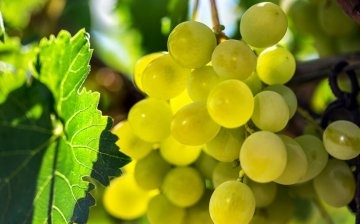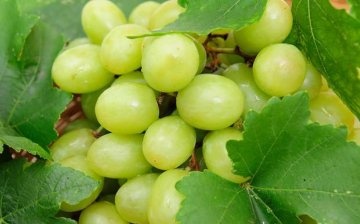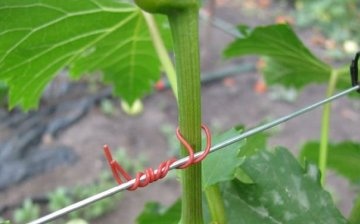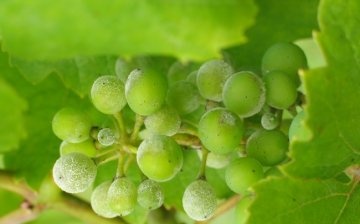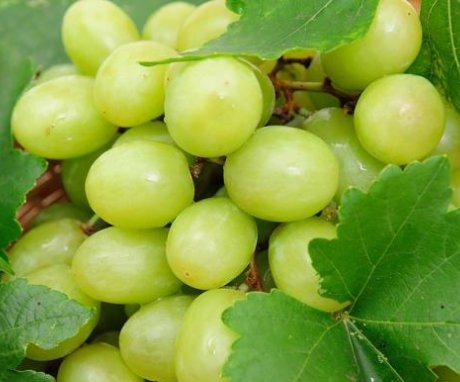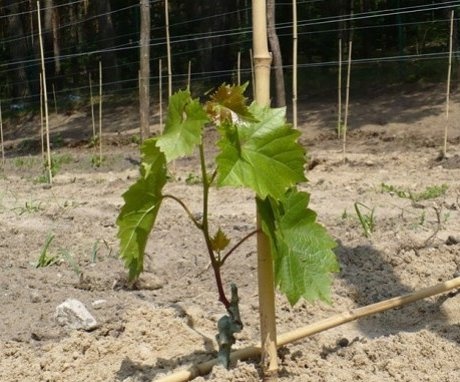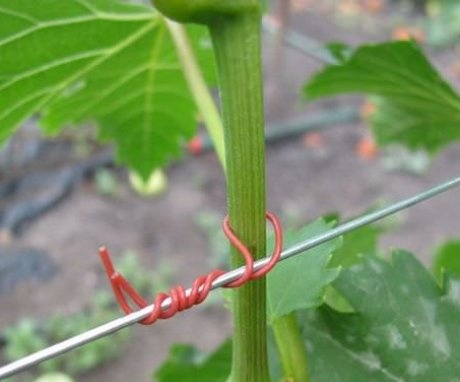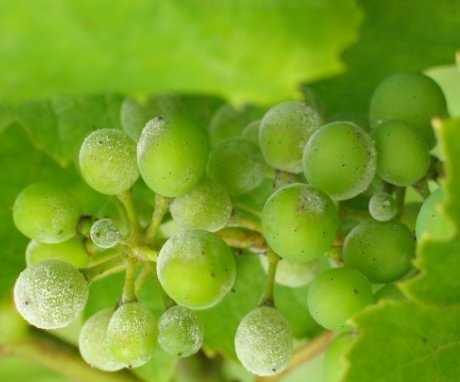Grapes "Harold": characteristics of the variety and agricultural technology
Early varieties of table grapes are especially popular, since, in addition to the fact that they can be enjoyed in July, they have an exquisite taste, are resistant to frost and disease.
By cultivating grapes, it is necessary to choose varieties based on the criteria of high yield, the ability of the vine to withstand diseases, cold climate. But the taste of the fruit also plays an important role. The table hybrid Harold, obtained by crossing "Muscat" with "Rapture" and "Arcadia", meets these requirements.
Content:
- Characteristics of the "Harold" variety, its advantages
- Rules, timing of planting varieties
- Recommendations for the care of grapes "Harold"
- Pest and disease control of grapes
Characteristics of the "Harold" variety, its advantages
Vigorous bushes grapes already in July, they delight with large bunches weighing up to five hundred grams each. The berries ripen completely within a hundred days. But the inflorescences must be normalized so that there is no overload of the vine. The fruit has a juicy pulp hidden under a dense but easily eaten skin. They are quite large, up to seven grams in weight, oval in shape with a pointed tip, do not crack during growth.
At the beginning of ripening, the color of the berries is white, then they become amber-yellow.
The fruit of "Harold" attracts a pleasant taste of nutmeg with a high level of sugar and a slight sourness. It ripens grapes for the entire length of the shoots, therefore it has a high yield. From one bush, you can collect up to fifteen kilograms of fragrant berries.
The advantage of the variety is its good transportability, abundant fruiting with a long preservation of taste, even remaining hanging on the bushes until autumn. The excellent taste of the table hybrid is used in the production of some wines. The positive qualities of the grapes, combined with ease of maintenance, have helped him become a popular owner of gardens in the temperate climatic zone.
Rules, timing of planting varieties
Rooted grape cuttings begin to be planted in the ground, usually in the spring, when the soil warms up at a depth of twenty centimeters to ten degrees Celsius. On average, this will be the period from the twenties of April to the beginning of May. It does not make sense to plant the vine later, as it will root poorly and may dry out. The best garden spot for "Harold" is the south or southwest side of the lot.
Knowledge of a special planting technique for table grapes is not required, it is important to comply with the terms of the procedure.
Soil for grapes is chosen neutral in acidity. Having dug up a piece of land prepared for planting fruit bushes, they form grooves into which they make mineral and organic fertilizers, moisturize them well. When planting a seedling, do not forget about the upper bud, leaving it above the soil surface. In a small depression formed around the planted vine, pour mulch... This small layer is necessary to retain moisture in the soil. For mulching, humus, peat, old fallen leaves, mown grass are suitable.
If the seedlings were purchased in the fall, then it will be necessary to store them in a cool place until spring, sprinkling them with a small layer of earth.If there is still time for planting, that is, two more weeks before the cold weather, then you can plant the vine, but covering it on top with plastic bottles and covering it with earth. For a secure fit, you can cover it with tarpaulin and fallen leaves.
Recommendations for the care of grapes "Harold"
Even, despite the unpretentiousness of fruit bushes, he needs proper care:
- The variety is indifferent to air humidity, it feels equally comfortable both in dry summers and during periods of rains. Watering is necessary for the vine immediately after removing the shelter from the vines. The next one is at the time of bud break, before flowering begins. Bushes need abundant watering during fruiting and after harvesting. For the procedure, it is better to use a drainage system, when small trenches are dug around, which are filled with water. One bush takes up to forty liters of water, and before winter - up to seventy.
- Getting into the fertilized soil during planting, the vines do not need feeding for the first four years of life. Then you need to add the entire spectrum mineral fertilizerscontaining nitrogen, phosphorus, potassium. The substances must be dissolved, therefore, two hundred grams of superphosphate, one hundred grams of ammonium nitrate, fifty grams of potassium salt are added to ten liters of water. Before the ripening of the bunches, ammonium nitrate is suitable for nutrition, and in the winter the vine needs potassium. Organic matter can be applied once every three to five years, this is also diluted chicken droppings, and rotted manure.
- The process will help to control the bush, its shape, the amount of harvest trimming... A vigorous bush "Harold" is not afraid of any kind of pruning: on the young branches of the bush there should be no more than thirty-five eyes, but on the secondary and twenty inflorescences are enough. Pruning will relieve the vine from overloading. "Harold" can please with the second harvest of the summer, if all inflorescences are removed from the stepchildren in time at the end of July. Then, in the last days of August, delicious berries will appear on them.
Proper care will increase the yield of the variety several times, protect the bushes from diseases.
Pest and disease control of grapes
Among the pests of vineyards, a false shield is distinguished, belonging to the hemiptera insects. By releasing a sticky liquid, the pests retard the growth of the vine, impair its development. Yellowish or brownish spots appear on the leaves of grapes, leading to necrosis of the affected parts of the plant. You can clean the stems and leaves of a bush from the parasite with a brush or cloth dipped in a solution of alcohol or soap. It is prepared from 15 grams of liquid soap, 10 milliliters of alcohol, diluted in a liter of warm water. In case of severe lesions, grape bushes are treated with Aktellik, spending two liters of the drug per 10 square meters of planting. Processing should be carried out no more than four times.
A spider mite is characterized by piercing of plant leaf tissues with subsequent damage to it.
Colonies of the parasite are visible on the cobweb threads entangling parts of the grape bush. Of the pests of grapes, felt itch, which belongs to the species of mites, is especially common. It spends the winter in cracks in the bark, in the remains of leaves, and spreads with the wind throughout the garden. When the leaves are itchy on the inside, blooms of a white felt layer are formed.
The influence of the parasite on the plant negatively affects the activity of the respiratory processes, changes in the amount and composition of amino acids. The yield of the bushes drops by 20 percent, and after two years, if you do not take action, the grapes may die. Individuals and larvae of ticks are destroyed using acaricidal preparations such as Sunmight. Treatment with a solution of colloidal sulfur or a five percent lime broth in the fall will help to destroy the parasite.
Although due to early ripening, Harold's vine is not susceptible to diseases, but prevention will not harm them:
- When infected with mildew, yellowish spots of various sizes and shapes appear on the leaves. In case of infection with an ailment, it is necessary to fight it with Bordeaux liquid, spraying the vine in the spring before flowering and at the end of it.
- All green parts of the plant suffer from oidium, they dry out and crack, brownish tubercles appear on the lignified trunks. The spores of the fungus hide in the buds of the infected shoots. During active growth, they must be treated with Fundazol planting several times with an interval of ten days.
- For gray rot, it costs nothing to destroy almost the entire grape harvest. The activity of the fungus grows during humid and hot summers. They will help to curb the development of the disease fungicidal agents, with which the bushes are treated three times during active growth.
Taking care of the vineyard will save you from diseases and pests, and will allow you to collect rich harvests of berries.
More information can be found in the video:



